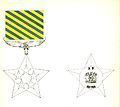English: South Africa instituted its own military orders, decorations and medals in 1952. However, South African equivalents of the British Distinguised Flying Cross (DFC) and Air Force Cross (AFC) were omitted at the time. This omission was only belatedly addressed at the end of the 1966-1989 Border War when the Air Force Command Council proposed the institution of the Air Force Cross (CA).
The decoration was originally intended for award only to aircrew who displayed exceptional courage and leadership during dangerous or critical situations while airborne and where an award for bravery was not suitable, based on the premise that bravery involves knowingly entering mortal danger from a position of relative safety, as opposed to skillfully reacting to an unforeseen situation of mortal danger. However, the other three Arms of the Service were quick to jump on the bandwagon, with the result that an Army Cross (CM), a Navy Cross (CN) and a Medical Service Cross (CC) were also instituted simultaneously. In the process the award criteria were watered down to outstanding ingenuity or skill in the utilisation and control of personnel, weaponry or other equipment in dangerous situations and not necessarily restricted to flying.
Since the requirement for a decoration equivalent to the British Distinguised Flying Cross (DFC) and Air Force Cross (AFC) still existed, the Air Force Command Council then proposed the institution of the Ad Astra Decoration (AAD) and Ad Astra Medal (AAM). As was originally intended with the Air Force Cross (CA), the criteria were again described in the draft warrant as excellent airmanship or outstanding ingenuity or skill during emergencies or critically unusual situations in the air. Both of the examples that came to mind would without doubt have qualified the respective pilots for the award of the equivalent of a DFC, had such a decoration existed in South Africa at the time.
- One example was an in-flight malfunction in a Canberra B(1) Mk. 12 that disabled the aircraft's control column. In spite of advice from the ground to ditch the aircraft since the pilot would be unlikely to be able to land it safely, he managed to land it with minimal damage while having only trim and rudder as controls.
- Another example was a Dakota C-47 that lost its rudder and elevators when struck by a surface-to-air missile, whose pilot managed to land safely by having his passengers, most of them serving Generals, move forward and backward in the cabin as required to alter the aircraft's centre of gravity.
Depicted is the first draft design of the Ad Astra Decoration, prepared by the State Herald's office. When presented to the Air Force Command Council, the following alterations were ordered:
- To avoid confusion about ribbon identity between the proposed AAD and the British DFC and AFC in photographs, the lines on the ribbon had to slant upwards toward the left shoulder, since both those decorations had been awarded to SAAF airmen during World War II.
- The ribbon colours had to be blue and white.
- The points of the star were "too fat" in the words of Maj Gen G.C. Nel, CAS Logistics at the time.
- The centre part of the obverse had to be redesigned.
(I was a Staff Officer at the SADF Personnel Division at the time, with the administration of military orders, decorations and medals as part of my duties, and I worked closely with the State Herald, Citizen Force Major Fred Brownell, in the design and approval of this and several other new decorations and medals in 1991. Fred Brownell, incidentally, also designed the new South African National Flag of 1994.)


